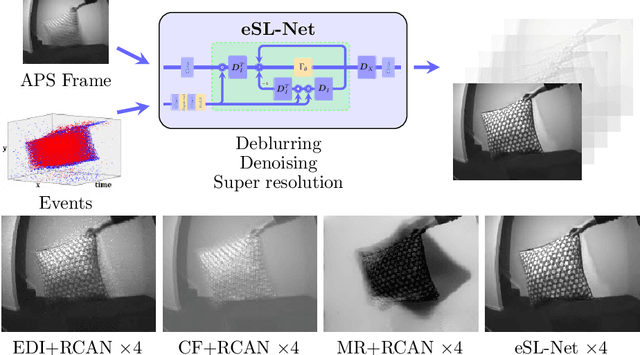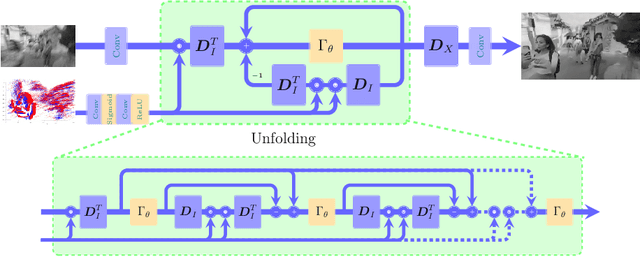Bishan Wang
Learning to Super-Resolve Blurry Images with Events
Feb 27, 2023Abstract:Super-Resolution from a single motion Blurred image (SRB) is a severely ill-posed problem due to the joint degradation of motion blurs and low spatial resolution. In this paper, we employ events to alleviate the burden of SRB and propose an Event-enhanced SRB (E-SRB) algorithm, which can generate a sequence of sharp and clear images with High Resolution (HR) from a single blurry image with Low Resolution (LR). To achieve this end, we formulate an event-enhanced degeneration model to consider the low spatial resolution, motion blurs, and event noises simultaneously. We then build an event-enhanced Sparse Learning Network (eSL-Net++) upon a dual sparse learning scheme where both events and intensity frames are modeled with sparse representations. Furthermore, we propose an event shuffle-and-merge scheme to extend the single-frame SRB to the sequence-frame SRB without any additional training process. Experimental results on synthetic and real-world datasets show that the proposed eSL-Net++ outperforms state-of-the-art methods by a large margin. Datasets, codes, and more results are available at https://github.com/ShinyWang33/eSL-Net-Plusplus.
Motion Deblurring with Real Events
Sep 28, 2021



Abstract:In this paper, we propose an end-to-end learning framework for event-based motion deblurring in a self-supervised manner, where real-world events are exploited to alleviate the performance degradation caused by data inconsistency. To achieve this end, optical flows are predicted from events, with which the blurry consistency and photometric consistency are exploited to enable self-supervision on the deblurring network with real-world data. Furthermore, a piece-wise linear motion model is proposed to take into account motion non-linearities and thus leads to an accurate model for the physical formation of motion blurs in the real-world scenario. Extensive evaluation on both synthetic and real motion blur datasets demonstrates that the proposed algorithm bridges the gap between simulated and real-world motion blurs and shows remarkable performance for event-based motion deblurring in real-world scenarios.
Event Enhanced High-Quality Image Recovery
Jul 16, 2020



Abstract:With extremely high temporal resolution, event cameras have a large potential for robotics and computer vision. However, their asynchronous imaging mechanism often aggravates the measurement sensitivity to noises and brings a physical burden to increase the image spatial resolution. To recover high-quality intensity images, one should address both denoising and super-resolution problems for event cameras. Since events depict brightness changes, with the enhanced degeneration model by the events, the clear and sharp high-resolution latent images can be recovered from the noisy, blurry and low-resolution intensity observations. Exploiting the framework of sparse learning, the events and the low-resolution intensity observations can be jointly considered. Based on this, we propose an explainable network, an event-enhanced sparse learning network (eSL-Net), to recover the high-quality images from event cameras. After training with a synthetic dataset, the proposed eSL-Net can largely improve the performance of the state-of-the-art by 7-12 dB. Furthermore, without additional training process, the proposed eSL-Net can be easily extended to generate continuous frames with frame-rate as high as the events.
 Add to Chrome
Add to Chrome Add to Firefox
Add to Firefox Add to Edge
Add to Edge